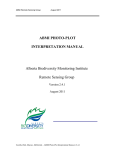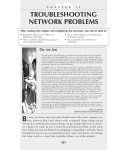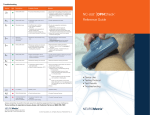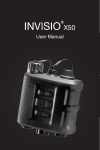Download Marshall PPHP Dog Collar with Lights Guide
Transcript
Introduction Congratulations on your purchase of a Marshall PowerPoint Collar w/ High Intensity Safety Lights. This high power tracking collar is designed to give the best range of any hound collar available while being the toughest and most rugged collar in the world. And best of all, it does all this while using standard AA batteries! The collar’s case was engineered using aerospace grade aluminum to give the strongest housing possible and is completely water-proof. It also incorporates an innovative On/Off magnetic switch that allows you to leave the collar on the dog when not in use, as well as two LED’s on the side of the transmitter that let you know when it’s running, and when it is time to change the batteries. Best of All, the PowerPoint HP collar is AFTCA approved for use in Field Trials! This manual will help you get the best results through a better understanding of the design and proper use in the field. Please take time to read it thoroughly before using your new Marshall Collar. On/Off Switch The Marshall key-chain magnet is used to turn the collar on/off. Simply tap the side of the collar, marked with the on/off symbol, with the magnet. When the transmitter is turned on with the magnet, it will send out three rapid pulses along with 3 rapid blinks of the green indicator. Practice giving it just a quick tap to turn it off. Unlike most collars on the market, you do not leave the magnet under the collar to keep the transmitter off, just a simple swipe or tap of the key chain magnet will do this. Turn the High Intensity Lights on/off, tap the light bulb symbol (located on the back side of the collar) with the magnet (Transmitter must be running before you can active the Lights). Note: Turning off the tracking collar will also turn off the High Intensity Lights. Caution: Do not store the magnet near your transmitters. If you have other collars with magnets installed to keep them turned off, store them away from your Marshall collars. Note: With a severely depleted battery the magnet controls on the transmitter may not work. Battery The Marshall collar uses 2 standard 1.5 Volt, AA Alkaline batteries readily available just about anywhere. We recommend using a good, name brand battery like Energizer or Duracell. The batteries are located under the battery lid (marked with the frequency of the collar) and are accessed be removing the two 4-40 Allen screws using the 3/32 Allen wrench embedded into the end of the key chain magnet. Insert the batteries with care as to their polarity. The “+” and “-“ ends are marked on the case. Note: For the Blue and Green collars, you may also use Energizer 1.5 Volt Lithium batteries (#L91) (silver and blue). They are lighter and will make the Green and Blue collars a bit brighter (not recommended for Red and Amber as there is little increase in performance over cheaper Alkaline AA’s). Caution: Do not use the 3.6 Volt Lithium batteries (green and white). This will run the collar at 7.2 Volts, which can damage the circuitry and void the warranty. Also, do not use rechargeable (NiCad) batteries in a Marshall collar, they will not provide good performance. Warning: to prevent possible battery leakage and corrosion, do not store collars for extended periods with the batteries installed. Batteries should be removed from collars if they are not going to be used for over 1 month. Activity Modes: The PowerPoint HP collar uses a sophisticated activity switch to determine what your dog is doing. The Two activity modes are: Running: When the dog is walking briskly or running, the collar should send out a medium paced signal – 55 pulses-per-minute (roughly one pulse every second). On Point: When the dog has treed or is upright, the transmitter will send out a fast, short signal – 110 pulses-per-minute (roughly two pulses every second). Marshall High Intensity Safety Lights You can run the transmitter by itself or with the High Intensity Lights. The High Intensity Lights make use of super bright LED’s which never need to be replaced. The High Intensity Lights are designed to turn off 15 hours after being switched on (enough to last until the sun comes up after one long winter night). The High Intensity Lights will also turn off if the batteries get low (red light comes on) but the radio transmitter keeps going, giving you time to recover your dog How long the collar will run (Lights On) and how far away you can see the High Intensity Lights depend on the color of the lights: Color Visual Range* 1/3 mile 1/4 mile 1/2 mile 1/2 mile Color 4 Hour Hunts with lights on* 14 14 6 6 Transmitter time after lights stop* 10 days 10 days 5 days 5 days The Blue and Green colors give you more time to run the lights, and more time to track. The Red and Amber colors are the brightest and can be seen the farthest, but they don’t last as long. If you want brightness, go with Red or Amber. If you prefer getting more life from a set of batteries, go with the Blue or Green. Note: all run times are approximate. Actual run times may vary. Battery Life – Transmitter Only (High Intensity Lights Off) The Marshall collar incorporates unique technology that causes the collar to conserve battery power if your dog gets lost. With the High Intensity Lights turned off, a pair of new batteries will transmit for about 6 weeks* continuously! Under normal usage, if you hunt every night for about 4 hours, the batteries will be good for about 4 months* or so. Low Battery Indicator When the battery starts getting low, the red indicator LED on the collar flashes, instead of the normal green one. It also gives you two quick beeps every tenth beep that you can hear on your receiver. Either of these conditions means that it is time to change the batteries. The transmitter will continue to run for 5 days or so after the double beep and the red indicator LED come on. The safety lights turn off automatically when the batteries get low and the red low battery indicator turns on. If you let the batteries rest for a few hours, they will recover. Low temperatures also affect the battery life and may trigger the red low battery warning, but when they warm up they may recover somewhat. After the batteries rest and warm up, turn the transmitter off and back on with your magnet. If the green light comes back on, you can keep using them safely. Just be aware that they are getting close to where you should replace them. Care and Maintenance: The Marshall collar is designed to be rugged and provide years of care free service. We do recommend that you periodically check the condition of your antenna and the O-ring seal on the battery lid. Antenna: made out of high strength industrial stainless steel cable and is very tough. In the event that the antenna becomes damaged, a replacement antenna may be installed in the field. O-Ring: we recommend that you check the condition of the O-ring each time you change batteries. If the O-ring is cracked or missing, install a replacement. It is advised to periodically lubricate the O-ring with a petroleum jelly (Vaseline) to help prevent binding and cracking. Replacement parts are available from your dealer or from Marshall Radio Telemetry direct. Range The Marshall tracking collar was designed to be the most powerful transmitter on the market. It should provide up to twice the range of most competitive high output models under most hunting conditions. Like any radio tracking collar, the range of the Marshall collar varies with the terrain. Tests have shown its range in the mountains of the western United States to be anywhere from 25 to 100 miles, depending on the height of the transmitter, the height of the receiver, and the type of terrain and obstructions. Typical eastern, forested hunting conditions give 5 to 20 miles. If you want to compare the Marshall collar with another transmitter, you must test them at the same time. The easiest way to do this is to hang the Marshall collar and the collar you are comparing, on a fence rail or level tree branch and do a drive off test. It is important that both collars be at the same height off of the ground, and that the antennas on both collars are facing vertically. A quick test can be done a short distance away judging the relative signal strengths on your receiver, but the best test is to drive off until you loose the first collar completely, then check the signal of your Marshall collar. As you are testing, be sure to rotate the yagi antenna on your receiver to the vertical position matching that of the collar's antenna to find the best signal strength for each collar. Remember that tests done in different places will always give different results. Even testing at different times of day can give different results. This is why you must always compare two transmitters by testing them together at the same time in the same place. Using the Receiver The normal way to hold your receiver is with the antenna horizontal. Horizontal gives more pinpoint accuracy, but if you are tracking a very weak signal, the vertical orientation might be better, so try both. The signal is strongest if the receiver antenna is lined up in the same orientation as the collar’s antenna. Since the collar’s orientation on the dog and the terrain can change, always try rotating your yagi from horizontal to vertical to attain the best signal possible. Horizontal Vertical Whatever range you get, you can be sure that the Marshall collar gives you the best signal you can possibly get under those specific conditions. Note for Tracker Maxima, Wildlife TRX1000, and Scanner users: Be sure to always tune the receiver up and down 1-2 KHz to make sure you are tuned in to the best signal. Example: for a 217.025 collar, try listening at 217.023,.024,.025,.026,.027. Select the frequency that gives you the best signal. Also, if the temperature changes drastically, you may want to re-tune in the collar as the receiver’s frequency may drift. *Times and distanc es are approxi mate. Your actual performance will vary depending on many factors, including temperature, dog motion patterns, how long you keep them on at a time, and battery differences. Batteries will last much longer if not used for long periods of time. They will go longer overall with lots of short hunts than with a few long hunts. Warranty Marshall Radio Telemetry warrants that the PowerPoint HP Collar will be free from defects of workmanship and materials for THREE YEARS from date of purchase. If you have a defective transmitter, return it to your distributor or Marshall Radio Telemetry and we will repair or replace it and return it free of charge. However, we will not be responsible for damage from misuse, normal damage incurred during use, and damage due to wear and tear. Under no circumstances will Marshall Radio be responsible for damages or loss beyond the value of the transmitter itself, including the loss of a dog or lost time. MARSHALL RADIO TELEMETRY 896 West 100 North, North Salt Lake, UT 84054 (801) 936-9000 or (800) 729-7123 With High Intensity Safety Lights User Manual Revision Jul - 2009

















